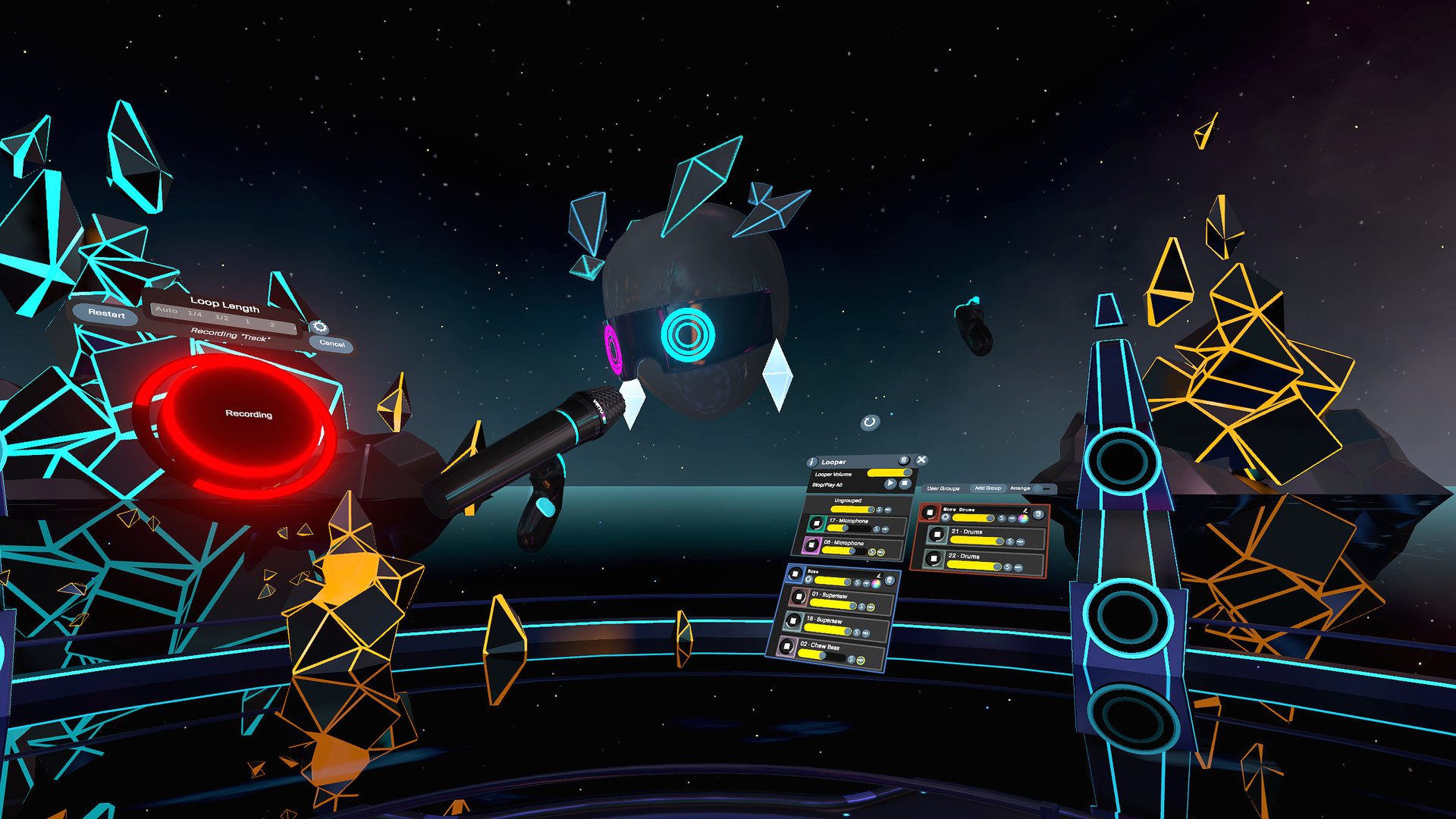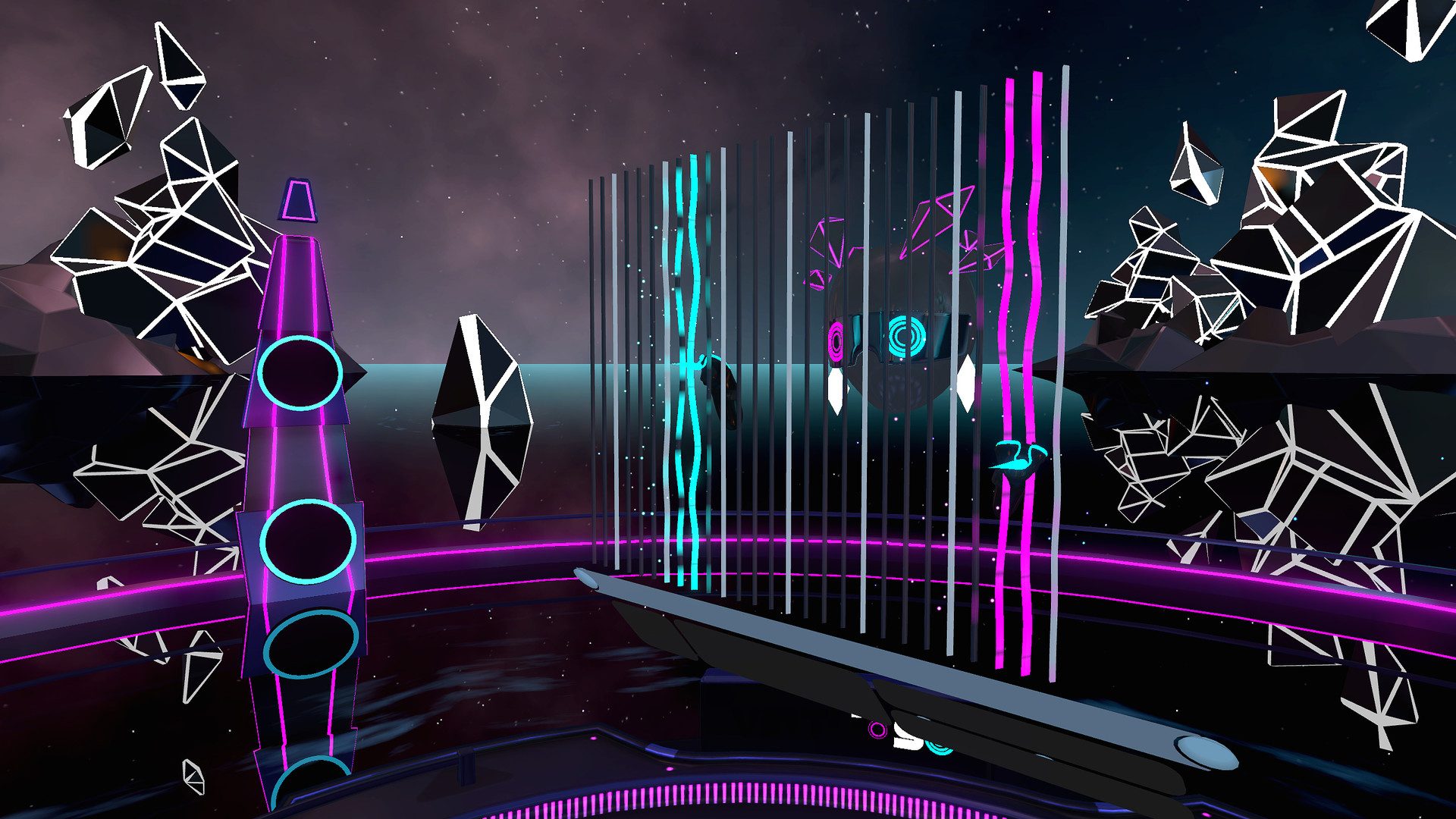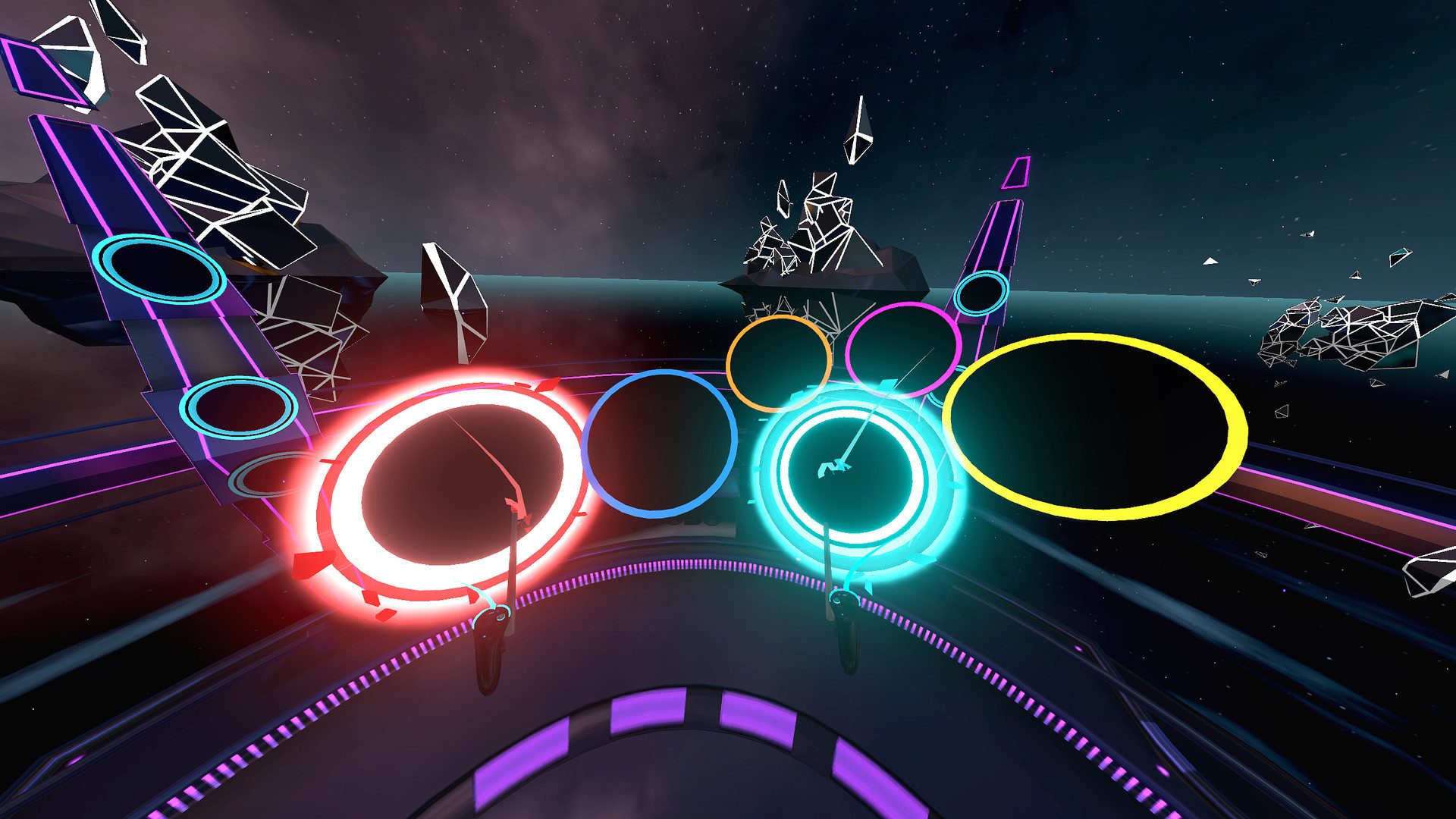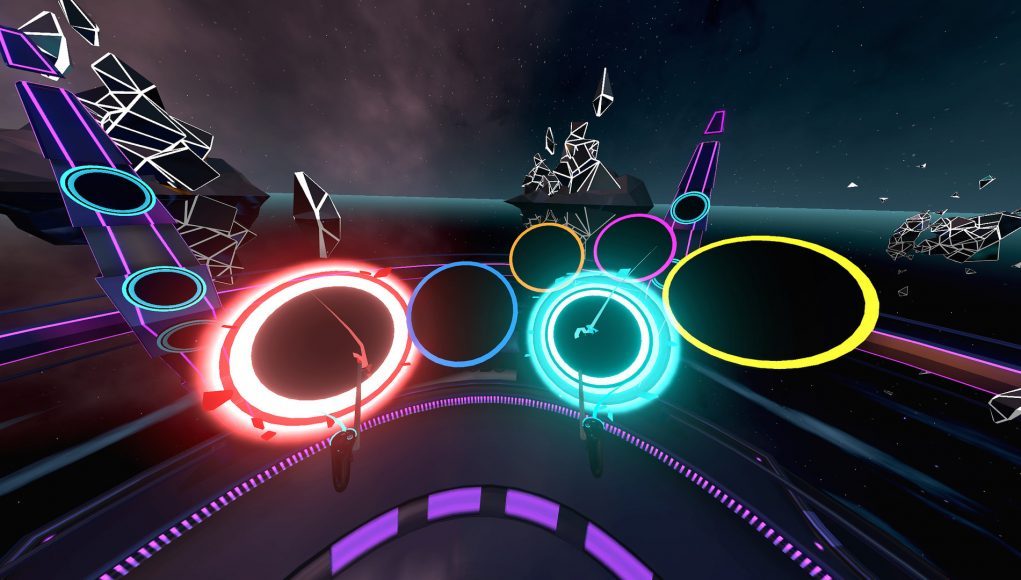Virtuoso bills itself as a “music creation sandbox” but that may be selling it a little short: it’s actually a very intuitive set of training wheels for someone who’s never made digital music before while at the same time being a fun way to make music. You’ll need to go deeper into the practice of music creation if you want to get pro results, although if you’re just looking to just mess around, or pursue a new hobby making music, Virtuoso has plenty of smartly-designed tools to get you started recording your own tunes in no time.
Virtuoso Details:
Available On: Quest, Oculus PC, SteamVR
Release Date: March 10th, 2022
Price: $20
Developer: Really Interactive AB
Publisher: Fast Travel Games
Reviewed On: Quest 2
Gameplay
Virtuoso isn’t as simple as Electronauts, which sterilizes the music making process somewhat with a heavy focus on syncopated instruments—meaning they automatically react as if you’ve hit them perfectly on strong beats. You can select your instruments to syncopate in Virtuoso, although this isn’t a default option, which makes it feel a little more targeted at people who are interested in fiddling around until they make something truly unique.
To be clear, Virtuoso didn’t get me in the same futuristic DJ-flavored flowstate as Electronauts: it expects you to learn about making music with a suitably reduced number of VR-friendly instruments and a microphone. There’s six instruments in total, each of them with multiple sound settings so you can squeeze out something that doesn’t just sound like it came straight out of the default options featured in any old music-making app. You can just as soon forget about the options and jam away though and still get some pretty cool results, but just know that you can go deeper.
The results can be awesome, but it’s worth noting that instruments can feel a bit imprecise when playing. Virtuoso gets around this somewhat by allowing you syncopate beats and then record and loop instruments. You may not be able to play a long and complicated tune on the harp or drums, but if you can manage to get a couple notes in, you can go back and loop something behind it to add to the complexity.

Looping is really simple. Hit the circle (seen above on the left, labeled ‘Looper’) and as soon as you start playing an instrument or singing into the mic, you’ll record a little section of your song. You can select how long you want the section by default—at anywhere from 1/4 to 32 beats—and whether you want a haptic metronome to fire in your controller to keep you synced.
You can start, stop, and change the volume on each loop or loop cluster once you’re happy with the result, and input name tags to keep everything straight. Once you’re ready, you can queue your loops (or clusters) and live mix them during the final recording process, which can output in either .wav or .midi formats. You’ll also be able to share your tracks to greater Virtuoso community for them to hear and mix.
To be clear: I’m not a musician. As a fan of both Reggie Watts and Bill Wurtz though, I just knew I had to make something strange off the top of my head as I put Virtuoso through its paces. The distressingly weird 7-song album that resulted over a few hours makes that pretty apparent (named after the contents of my spam folder).
Note: ‘Metaverse Investment Scheme’ was mixed in-headset and exported to wav. None of it was touched up outside of VR, which is easier to do with midi. I found you can get a pretty decent result doing it this way, although being able to better control with a third-party program would make for a cleaner, and likely more refined result. Some tracks are louder than others, and would no doubt benefit from increased control in general.
If you listened to any of the tracks above, you probably heard some looping issues. This is because I was creating them while learning the interface. The last track, ‘Chaos Hussar’, was my earliest attempt and is objectively a terrible, off-putting cacophony of guttural noises. If you know anything about music creation, I’m confident you will make better music than me.
Still, I’m left a little dumbfounded at what you can do with Virtuoso with just a VR headset and two motion controllers. No special equipment required.

And even after spitting out a bunch of tracks, many of them bad, I feel like there’s a lot more to learn about recording instruments and playing back through the looper. At times I wished I had the ability to cut and paste, or shorten loops and put them in sequential order like a 2D interface might provide, but that’s probably not be the point of Virtuoso.
Like any tool, learning more about the app’s quirks will only give you better results, and really exploring each setting to produce just one song (not seven hastily made songs) will undoubtedly feel like, well, you made real music that you wouldn’t be ashamed to hang up on a real SoundCloud account. It’s about getting your feet wet and experimenting with a new way of creating music.
Immersion
Virtuoso only offers four immersive environments, which seems a little on the low side. At least on Quest, one of those backgrounds is passthrough mode, so you place down virtual instruments in your room and keep an eye on the physical world at the same time.
Virtuoso however manages to cram in such a respectable number of settings and instrument variations that you’ll be focusing on playing and recording and less on your environment, I found. A plane white background is available if you just want to zone in on music.

Because VR is missing physical resistance —a big component in the sense of touch—playing instruments can generally feel a little transient and imprecise. This inherent issue can be mitigated in three fundamental ways. You can resize instruments and drum heads to be larger targets, which make them easier to hit individually. You can syncopate beats to make them ‘snap’ into where they need to be. And you can focus more on looping so you can generate repeating riffs that you can slowly layer to built more interesting tunes.
This last method is a little more fiddly than getting something slick all in one go, since it means you’ll have a giant list of loops to categorize and adjust before hitting the final tape recorder button. Keeping track of things is a bit annoying since it relies on a virtual keyboard, but that’s just the state of things I suppose.
Again, I know if I spent more time with Virtuoso focusing on just one song, I may be able to come up with something that might approach a professional sound—that’s with no real experience outside of knowing what music sounds like (more or less). As it is, all of my songs feel like they have very similar loop progression, something you can automate better by selecting when loops fade in and out, and how. That part is less intuitive, and requires a visit to the tutorial to really grasp.
Comfort
Instruments can be as big or small as you want by grabbing them with both hands and stretching them out, and can be positioned anywhere in space, meaning you use Virtuoso in an conceivable position, seated, standing, or even laying down. I found myself switching between sitting and standing, because standing naturally gives you more real-estate to fill with instruments.
Since there’s no artificial locomotion to speak of, Virtuoso proves to be one of the most comfortable experiences out there.
‘Virtuoso’ Comfort Settings – March 10th, 2022 |
|
Turning |
|
| Artificial turning | ✖ |
| Smooth-turn | ✖ |
| Adjustable speed | n/a |
| Snap-turn | ✖ |
| Adjustable increments | n/a |
Movement |
|
| Artificial movement | ✖ |
| Smooth-move | ✖ |
| Adjustable speed | n/a |
| Teleport-move | ✖ |
| Blinders | ✖ |
| Adjustable strength | n/a |
| Head-based | ✖ |
| Controller-based | ✖ |
| Swappable movement hand | ✖ |
Posture |
|
| Standing mode | ✔ |
| Seated mode | ✔ |
| Artificial crouch | n/a |
| Real crouch | n/a |
Accessibility |
|
| Subtitles | ✖ |
| Languages | n/a |
| Alternate audio | ✖ |
| Languages | n/a |
| Adjustable difficulty | ✖ |
| Two hands required | ✖ |
| Real crouch required | ✖ |
| Hearing required | ✔ |
| Adjustable player height | ✖ |







